标签:ima nod character code app val interval start instr

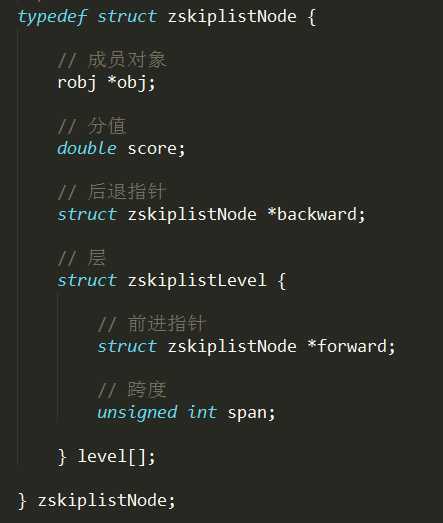
1.1 层
层的数量越多,访问其他节点的速度越快;

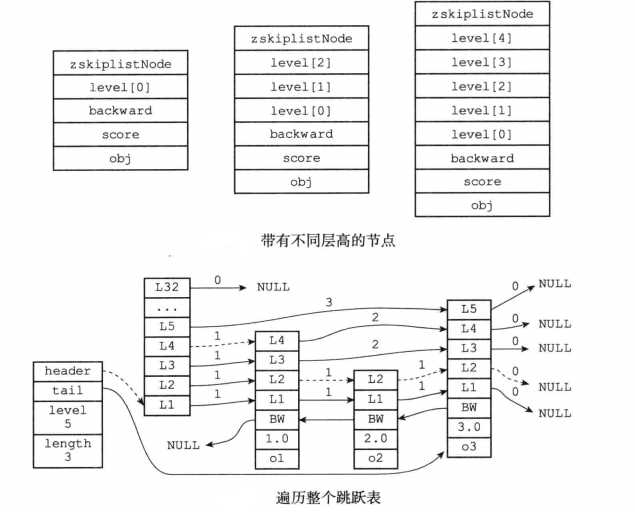
步骤


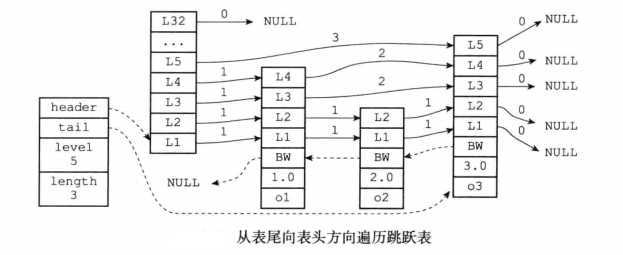
1.5 分值和成员

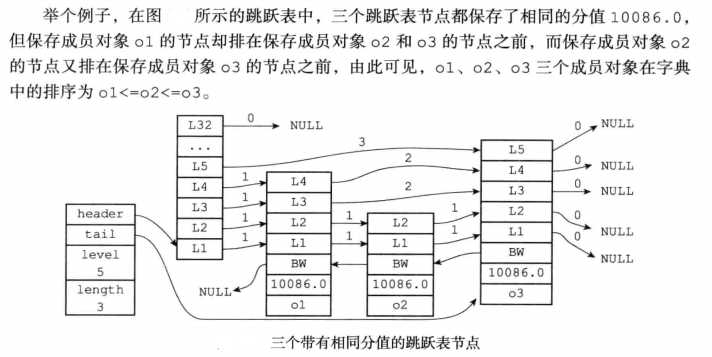
2 跳跃表结构
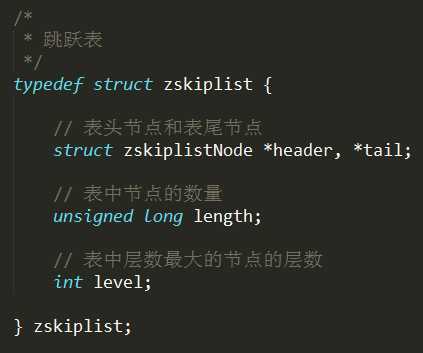
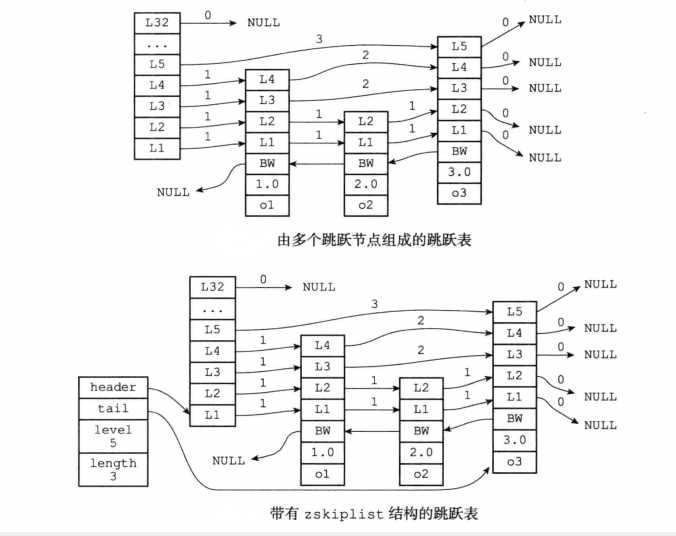
3 跳跃表API

/* * 创建一个层数为 level 的跳跃表节点, * 并将节点的成员对象设置为 obj ,分值设置为 score 。 * * 返回值为新创建的跳跃表节点 * * T = O(1) */ zskiplistNode *zslCreateNode(int level, double score, robj *obj) { // 分配空间 zskiplistNode *zn = zmalloc(sizeof(*zn)+level*sizeof(struct zskiplistLevel)); // 设置属性 zn->score = score; zn->obj = obj; return zn; } /* * 创建并返回一个新的跳跃表 * * T = O(1) */ zskiplist *zslCreate(void) { int j; zskiplist *zsl; // 分配空间 zsl = zmalloc(sizeof(*zsl)); // 设置高度和起始层数 zsl->level = 1; zsl->length = 0; // 初始化表头节点 // T = O(1) zsl->header = zslCreateNode(ZSKIPLIST_MAXLEVEL,0,NULL); for (j = 0; j < ZSKIPLIST_MAXLEVEL; j++) { zsl->header->level[j].forward = NULL; zsl->header->level[j].span = 0; } zsl->header->backward = NULL; // 设置表尾 zsl->tail = NULL; return zsl; } /* * 释放给定的跳跃表节点 * * T = O(1) */ void zslFreeNode(zskiplistNode *node) { decrRefCount(node->obj); zfree(node); } /* * 释放给定跳跃表,以及表中的所有节点 * * T = O(N) */ void zslFree(zskiplist *zsl) { zskiplistNode *node = zsl->header->level[0].forward, *next; // 释放表头 zfree(zsl->header); // 释放表中所有节点 // T = O(N) while(node) { next = node->level[0].forward; zslFreeNode(node); node = next; } // 释放跳跃表结构 zfree(zsl); } /* Returns a random level for the new skiplist node we are going to create. * * 返回一个随机值,用作新跳跃表节点的层数。 * * The return value of this function is between 1 and ZSKIPLIST_MAXLEVEL * (both inclusive), with a powerlaw-alike distribution where higher * levels are less likely to be returned. * * 返回值介乎 1 和 ZSKIPLIST_MAXLEVEL 之间(包含 ZSKIPLIST_MAXLEVEL), * 根据随机算法所使用的幂次定律,越大的值生成的几率越小。 * * T = O(N) */ int zslRandomLevel(void) { int level = 1; while ((random()&0xFFFF) < (ZSKIPLIST_P * 0xFFFF)) level += 1; return (level<ZSKIPLIST_MAXLEVEL) ? level : ZSKIPLIST_MAXLEVEL; } /* * 创建一个成员为 obj ,分值为 score 的新节点, * 并将这个新节点插入到跳跃表 zsl 中。 * * 函数的返回值为新节点。 * * T_wrost = O(N^2), T_avg = O(N log N) */ zskiplistNode *zslInsert(zskiplist *zsl, double score, robj *obj) { zskiplistNode *update[ZSKIPLIST_MAXLEVEL], *x; unsigned int rank[ZSKIPLIST_MAXLEVEL]; int i, level; redisAssert(!isnan(score)); // 在各个层查找节点的插入位置 // T_wrost = O(N^2), T_avg = O(N log N) x = zsl->header; for (i = zsl->level-1; i >= 0; i--) { /* store rank that is crossed to reach the insert position */ // 如果 i 不是 zsl->level-1 层 // 那么 i 层的起始 rank 值为 i+1 层的 rank 值 // 各个层的 rank 值一层层累积 // 最终 rank[0] 的值加一就是新节点的前置节点的排位 // rank[0] 会在后面成为计算 span 值和 rank 值的基础 rank[i] = i == (zsl->level-1) ? 0 : rank[i+1]; // 沿着前进指针遍历跳跃表 // T_wrost = O(N^2), T_avg = O(N log N) while (x->level[i].forward && (x->level[i].forward->score < score || // 比对分值 (x->level[i].forward->score == score && // 比对成员, T = O(N) compareStringObjects(x->level[i].forward->obj,obj) < 0))) { // 记录沿途跨越了多少个节点 rank[i] += x->level[i].span; // 移动至下一指针 x = x->level[i].forward; } // 记录将要和新节点相连接的节点 update[i] = x; } /* we assume the key is not already inside, since we allow duplicated * scores, and the re-insertion of score and redis object should never * happen since the caller of zslInsert() should test in the hash table * if the element is already inside or not. * * zslInsert() 的调用者会确保同分值且同成员的元素不会出现, * 所以这里不需要进一步进行检查,可以直接创建新元素。 */ // 获取一个随机值作为新节点的层数 // T = O(N) level = zslRandomLevel(); // 如果新节点的层数比表中其他节点的层数都要大 // 那么初始化表头节点中未使用的层,并将它们记录到 update 数组中 // 将来也指向新节点 if (level > zsl->level) { // 初始化未使用层 // T = O(1) for (i = zsl->level; i < level; i++) { rank[i] = 0; update[i] = zsl->header; update[i]->level[i].span = zsl->length; } // 更新表中节点最大层数 zsl->level = level; } // 创建新节点 x = zslCreateNode(level,score,obj); // 将前面记录的指针指向新节点,并做相应的设置 // T = O(1) for (i = 0; i < level; i++) { // 设置新节点的 forward 指针 x->level[i].forward = update[i]->level[i].forward; // 将沿途记录的各个节点的 forward 指针指向新节点 update[i]->level[i].forward = x; /* update span covered by update[i] as x is inserted here */ // 计算新节点跨越的节点数量 x->level[i].span = update[i]->level[i].span - (rank[0] - rank[i]); // 更新新节点插入之后,沿途节点的 span 值 // 其中的 +1 计算的是新节点 update[i]->level[i].span = (rank[0] - rank[i]) + 1; } /* increment span for untouched levels */ // 未接触的节点的 span 值也需要增一,这些节点直接从表头指向新节点 // T = O(1) for (i = level; i < zsl->level; i++) { update[i]->level[i].span++; } // 设置新节点的后退指针 x->backward = (update[0] == zsl->header) ? NULL : update[0]; if (x->level[0].forward) x->level[0].forward->backward = x; else zsl->tail = x; // 跳跃表的节点计数增一 zsl->length++; return x; } /* Internal function used by zslDelete, zslDeleteByScore and zslDeleteByRank * * 内部删除函数, * 被 zslDelete 、 zslDeleteRangeByScore 和 zslDeleteByRank 等函数调用。 * * T = O(1) */ void zslDeleteNode(zskiplist *zsl, zskiplistNode *x, zskiplistNode **update) { int i; // 更新所有和被删除节点 x 有关的节点的指针,解除它们之间的关系 // T = O(1) for (i = 0; i < zsl->level; i++) { if (update[i]->level[i].forward == x) { update[i]->level[i].span += x->level[i].span - 1; update[i]->level[i].forward = x->level[i].forward; } else { update[i]->level[i].span -= 1; } } // 更新被删除节点 x 的前进和后退指针 if (x->level[0].forward) { x->level[0].forward->backward = x->backward; } else { zsl->tail = x->backward; } // 更新跳跃表最大层数(只在被删除节点是跳跃表中最高的节点时才执行) // T = O(1) while(zsl->level > 1 && zsl->header->level[zsl->level-1].forward == NULL) zsl->level--; // 跳跃表节点计数器减一 zsl->length--; } /* Delete an element with matching score/object from the skiplist. * * 从跳跃表 zsl 中删除包含给定节点 score 并且带有指定对象 obj 的节点。 * * T_wrost = O(N^2), T_avg = O(N log N) */ int zslDelete(zskiplist *zsl, double score, robj *obj) { zskiplistNode *update[ZSKIPLIST_MAXLEVEL], *x; int i; // 遍历跳跃表,查找目标节点,并记录所有沿途节点 // T_wrost = O(N^2), T_avg = O(N log N) x = zsl->header; for (i = zsl->level-1; i >= 0; i--) { // 遍历跳跃表的复杂度为 T_wrost = O(N), T_avg = O(log N) while (x->level[i].forward && (x->level[i].forward->score < score || // 比对分值 (x->level[i].forward->score == score && // 比对对象,T = O(N) compareStringObjects(x->level[i].forward->obj,obj) < 0))) // 沿着前进指针移动 x = x->level[i].forward; // 记录沿途节点 update[i] = x; } /* We may have multiple elements with the same score, what we need * is to find the element with both the right score and object. * * 检查找到的元素 x ,只有在它的分值和对象都相同时,才将它删除。 */ x = x->level[0].forward; if (x && score == x->score && equalStringObjects(x->obj,obj)) { // T = O(1) zslDeleteNode(zsl, x, update); // T = O(1) zslFreeNode(x); return 1; } else { return 0; /* not found */ } return 0; /* not found */ }
4.2 访问,比较,排序
/* * 检测给定值 value 是否大于(或大于等于)范围 spec 中的 min 项。 * * 返回 1 表示 value 大于等于 min 项,否则返回 0 。 * * T = O(1) */ static int zslValueGteMin(double value, zrangespec *spec) { return spec->minex ? (value > spec->min) : (value >= spec->min); } /* * 检测给定值 value 是否小于(或小于等于)范围 spec 中的 max 项。 * * 返回 1 表示 value 小于等于 max 项,否则返回 0 。 * * T = O(1) */ static int zslValueLteMax(double value, zrangespec *spec) { return spec->maxex ? (value < spec->max) : (value <= spec->max); } /* Returns if there is a part of the zset is in range. * * 如果给定的分值范围包含在跳跃表的分值范围之内, * 那么返回 1 ,否则返回 0 。 * * T = O(1) */ int zslIsInRange(zskiplist *zsl, zrangespec *range) { zskiplistNode *x; /* Test for ranges that will always be empty. */ // 先排除总为空的范围值 if (range->min > range->max || (range->min == range->max && (range->minex || range->maxex))) return 0; // 检查最大分值 x = zsl->tail; if (x == NULL || !zslValueGteMin(x->score,range)) return 0; // 检查最小分值 x = zsl->header->level[0].forward; if (x == NULL || !zslValueLteMax(x->score,range)) return 0; return 1; } /* Find the first node that is contained in the specified range. * * 返回 zsl 中第一个分值符合 range 中指定范围的节点。 * Returns NULL when no element is contained in the range. * * 如果 zsl 中没有符合范围的节点,返回 NULL 。 * * T_wrost = O(N), T_avg = O(log N) */ zskiplistNode *zslFirstInRange(zskiplist *zsl, zrangespec *range) { zskiplistNode *x; int i; /* If everything is out of range, return early. */ if (!zslIsInRange(zsl,range)) return NULL; // 遍历跳跃表,查找符合范围 min 项的节点 // T_wrost = O(N), T_avg = O(log N) x = zsl->header; for (i = zsl->level-1; i >= 0; i--) { /* Go forward while *OUT* of range. */ while (x->level[i].forward && !zslValueGteMin(x->level[i].forward->score,range)) x = x->level[i].forward; } /* This is an inner range, so the next node cannot be NULL. */ x = x->level[0].forward; redisAssert(x != NULL); /* Check if score <= max. */ // 检查节点是否符合范围的 max 项 // T = O(1) if (!zslValueLteMax(x->score,range)) return NULL; return x; } /* Find the last node that is contained in the specified range. * Returns NULL when no element is contained in the range. * * 返回 zsl 中最后一个分值符合 range 中指定范围的节点。 * * 如果 zsl 中没有符合范围的节点,返回 NULL 。 * * T_wrost = O(N), T_avg = O(log N) */ zskiplistNode *zslLastInRange(zskiplist *zsl, zrangespec *range) { zskiplistNode *x; int i; /* If everything is out of range, return early. */ // 先确保跳跃表中至少有一个节点符合 range 指定的范围, // 否则直接失败 // T = O(1) if (!zslIsInRange(zsl,range)) return NULL; // 遍历跳跃表,查找符合范围 max 项的节点 // T_wrost = O(N), T_avg = O(log N) x = zsl->header; for (i = zsl->level-1; i >= 0; i--) { /* Go forward while *IN* range. */ while (x->level[i].forward && zslValueLteMax(x->level[i].forward->score,range)) x = x->level[i].forward; } /* This is an inner range, so this node cannot be NULL. */ redisAssert(x != NULL); /* Check if score >= min. */ // 检查节点是否符合范围的 min 项 // T = O(1) if (!zslValueGteMin(x->score,range)) return NULL; // 返回节点 return x; } /* Delete all the elements with score between min and max from the skiplist. * * 删除所有分值在给定范围之内的节点。 * * Min and max are inclusive, so a score >= min || score <= max is deleted. * * min 和 max 参数都是包含在范围之内的,所以分值 >= min 或 <= max 的节点都会被删除。 * * Note that this function takes the reference to the hash table view of the * sorted set, in order to remove the elements from the hash table too. * * 节点不仅会从跳跃表中删除,而且会从相应的字典中删除。 * * 返回值为被删除节点的数量 * * T = O(N) */ unsigned long zslDeleteRangeByScore(zskiplist *zsl, zrangespec *range, dict *dict) { zskiplistNode *update[ZSKIPLIST_MAXLEVEL], *x; unsigned long removed = 0; int i; // 记录所有和被删除节点(们)有关的节点 // T_wrost = O(N) , T_avg = O(log N) x = zsl->header; for (i = zsl->level-1; i >= 0; i--) { while (x->level[i].forward && (range->minex ? x->level[i].forward->score <= range->min : x->level[i].forward->score < range->min)) x = x->level[i].forward; update[i] = x; } /* Current node is the last with score < or <= min. */ // 定位到给定范围开始的第一个节点 x = x->level[0].forward; /* Delete nodes while in range. */ // 删除范围中的所有节点 // T = O(N) while (x && (range->maxex ? x->score < range->max : x->score <= range->max)) { // 记录下个节点的指针 zskiplistNode *next = x->level[0].forward; zslDeleteNode(zsl,x,update); dictDelete(dict,x->obj); zslFreeNode(x); removed++; x = next; } return removed; } unsigned long zslDeleteRangeByLex(zskiplist *zsl, zlexrangespec *range, dict *dict) { zskiplistNode *update[ZSKIPLIST_MAXLEVEL], *x; unsigned long removed = 0; int i; x = zsl->header; for (i = zsl->level-1; i >= 0; i--) { while (x->level[i].forward && !zslLexValueGteMin(x->level[i].forward->obj,range)) x = x->level[i].forward; update[i] = x; } /* Current node is the last with score < or <= min. */ x = x->level[0].forward; /* Delete nodes while in range. */ while (x && zslLexValueLteMax(x->obj,range)) { zskiplistNode *next = x->level[0].forward; // 从跳跃表中删除当前节点 zslDeleteNode(zsl,x,update); // 从字典中删除当前节点 dictDelete(dict,x->obj); // 释放当前跳跃表节点的结构 zslFreeNode(x); // 增加删除计数器 removed++; // 继续处理下个节点 x = next; } // 返回被删除节点的数量 return removed; } /* Delete all the elements with rank between start and end from the skiplist. * * 从跳跃表中删除所有给定排位内的节点。 * * Start and end are inclusive. Note that start and end need to be 1-based * * start 和 end 两个位置都是包含在内的。注意它们都是以 1 为起始值。 * * 函数的返回值为被删除节点的数量。 * * T = O(N) */ unsigned long zslDeleteRangeByRank(zskiplist *zsl, unsigned int start, unsigned int end, dict *dict) { zskiplistNode *update[ZSKIPLIST_MAXLEVEL], *x; unsigned long traversed = 0, removed = 0; int i; // 沿着前进指针移动到指定排位的起始位置,并记录所有沿途指针 // T_wrost = O(N) , T_avg = O(log N) x = zsl->header; for (i = zsl->level-1; i >= 0; i--) { while (x->level[i].forward && (traversed + x->level[i].span) < start) { traversed += x->level[i].span; x = x->level[i].forward; } update[i] = x; } // 移动到排位的起始的第一个节点 traversed++; x = x->level[0].forward; // 删除所有在给定排位范围内的节点 // T = O(N) while (x && traversed <= end) { // 记录下一节点的指针 zskiplistNode *next = x->level[0].forward; // 从跳跃表中删除节点 zslDeleteNode(zsl,x,update); // 从字典中删除节点 dictDelete(dict,x->obj); // 释放节点结构 zslFreeNode(x); // 为删除计数器增一 removed++; // 为排位计数器增一 traversed++; // 处理下个节点 x = next; } // 返回被删除节点的数量 return removed; } /* Find the rank for an element by both score and key. * * 查找包含给定分值和成员对象的节点在跳跃表中的排位。 * * Returns 0 when the element cannot be found, rank otherwise. * * 如果没有包含给定分值和成员对象的节点,返回 0 ,否则返回排位。 * * Note that the rank is 1-based due to the span of zsl->header to the * first element. * * 注意,因为跳跃表的表头也被计算在内,所以返回的排位以 1 为起始值。 * * T_wrost = O(N), T_avg = O(log N) */ unsigned long zslGetRank(zskiplist *zsl, double score, robj *o) { zskiplistNode *x; unsigned long rank = 0; int i; // 遍历整个跳跃表 x = zsl->header; for (i = zsl->level-1; i >= 0; i--) { // 遍历节点并对比元素 while (x->level[i].forward && (x->level[i].forward->score < score || // 比对分值 (x->level[i].forward->score == score && // 比对成员对象 compareStringObjects(x->level[i].forward->obj,o) <= 0))) { // 累积跨越的节点数量 rank += x->level[i].span; // 沿着前进指针遍历跳跃表 x = x->level[i].forward; } /* x might be equal to zsl->header, so test if obj is non-NULL */ // 必须确保不仅分值相等,而且成员对象也要相等 // T = O(N) if (x->obj && equalStringObjects(x->obj,o)) { return rank; } } // 没找到 return 0; } /* Finds an element by its rank. The rank argument needs to be 1-based. * * 根据排位在跳跃表中查找元素。排位的起始值为 1 。 * * 成功查找返回相应的跳跃表节点,没找到则返回 NULL 。 * * T_wrost = O(N), T_avg = O(log N) */ zskiplistNode* zslGetElementByRank(zskiplist *zsl, unsigned long rank) { zskiplistNode *x; unsigned long traversed = 0; int i; // T_wrost = O(N), T_avg = O(log N) x = zsl->header; for (i = zsl->level-1; i >= 0; i--) { // 遍历跳跃表并累积越过的节点数量 while (x->level[i].forward && (traversed + x->level[i].span) <= rank) { traversed += x->level[i].span; x = x->level[i].forward; } // 如果越过的节点数量已经等于 rank // 那么说明已经到达要找的节点 if (traversed == rank) { return x; } } // 没找到目标节点 return NULL; } /* Populate the rangespec according to the objects min and max. * * 对 min 和 max 进行分析,并将区间的值保存在 spec 中。 * * 分析成功返回 REDIS_OK ,分析出错导致失败返回 REDIS_ERR 。 * * T = O(N) */ static int zslParseRange(robj *min, robj *max, zrangespec *spec) { char *eptr; // 默认为闭区间 spec->minex = spec->maxex = 0; /* Parse the min-max interval. If one of the values is prefixed * by the "(" character, it‘s considered "open". For instance * ZRANGEBYSCORE zset (1.5 (2.5 will match min < x < max * ZRANGEBYSCORE zset 1.5 2.5 will instead match min <= x <= max */ if (min->encoding == REDIS_ENCODING_INT) { // min 的值为整数,开区间 spec->min = (long)min->ptr; } else { // min 对象为字符串,分析 min 的值并决定区间 if (((char*)min->ptr)[0] == ‘(‘) { // T = O(N) spec->min = strtod((char*)min->ptr+1,&eptr); if (eptr[0] != ‘\0‘ || isnan(spec->min)) return REDIS_ERR; spec->minex = 1; } else { // T = O(N) spec->min = strtod((char*)min->ptr,&eptr); if (eptr[0] != ‘\0‘ || isnan(spec->min)) return REDIS_ERR; } } if (max->encoding == REDIS_ENCODING_INT) { // max 的值为整数,开区间 spec->max = (long)max->ptr; } else { // max 对象为字符串,分析 max 的值并决定区间 if (((char*)max->ptr)[0] == ‘(‘) { // T = O(N) spec->max = strtod((char*)max->ptr+1,&eptr); if (eptr[0] != ‘\0‘ || isnan(spec->max)) return REDIS_ERR; spec->maxex = 1; } else { // T = O(N) spec->max = strtod((char*)max->ptr,&eptr); if (eptr[0] != ‘\0‘ || isnan(spec->max)) return REDIS_ERR; } } return REDIS_OK; } /* ------------------------ Lexicographic ranges ---------------------------- */ /* Parse max or min argument of ZRANGEBYLEX. * (foo means foo (open interval) * [foo means foo (closed interval) * - means the min string possible * + means the max string possible * * If the string is valid the *dest pointer is set to the redis object * that will be used for the comparision, and ex will be set to 0 or 1 * respectively if the item is exclusive or inclusive. REDIS_OK will be * returned. * * If the string is not a valid range REDIS_ERR is returned, and the value * of *dest and *ex is undefined. */ int zslParseLexRangeItem(robj *item, robj **dest, int *ex) { char *c = item->ptr; switch(c[0]) { case ‘+‘: if (c[1] != ‘\0‘) return REDIS_ERR; *ex = 0; *dest = shared.maxstring; incrRefCount(shared.maxstring); return REDIS_OK; case ‘-‘: if (c[1] != ‘\0‘) return REDIS_ERR; *ex = 0; *dest = shared.minstring; incrRefCount(shared.minstring); return REDIS_OK; case ‘(‘: *ex = 1; *dest = createStringObject(c+1,sdslen(c)-1); return REDIS_OK; case ‘[‘: *ex = 0; *dest = createStringObject(c+1,sdslen(c)-1); return REDIS_OK; default: return REDIS_ERR; } }
还有一些设计对象的源代码,还没有看懂,大家自己可以去找源代码分析
标签:ima nod character code app val interval start instr
原文地址:http://www.cnblogs.com/tao-alex/p/6358390.html